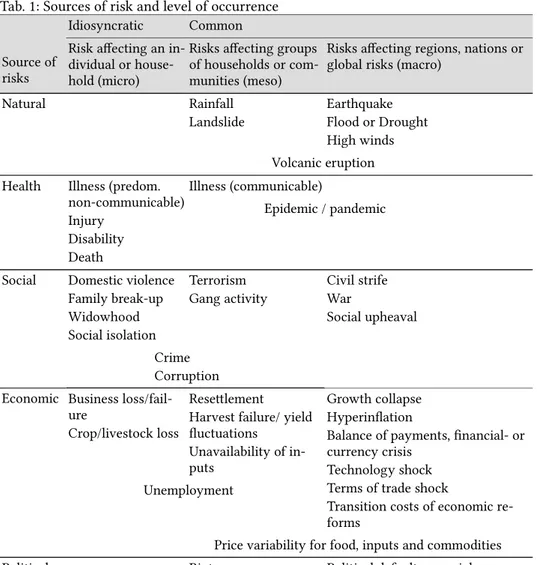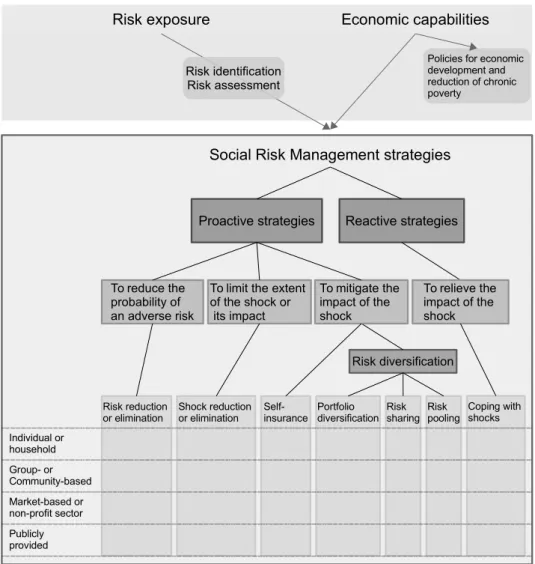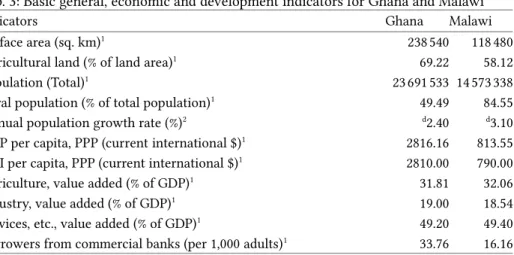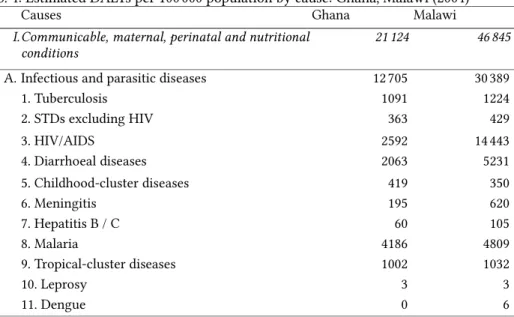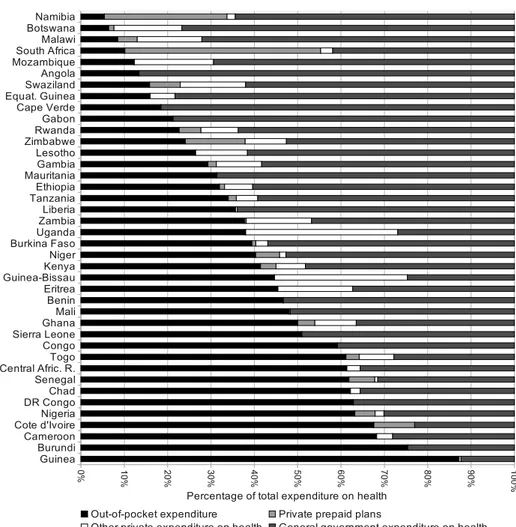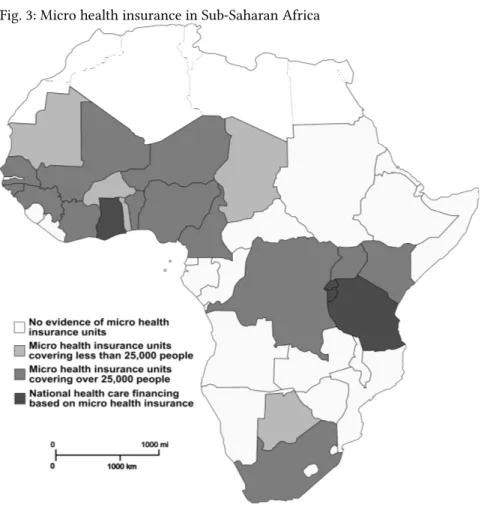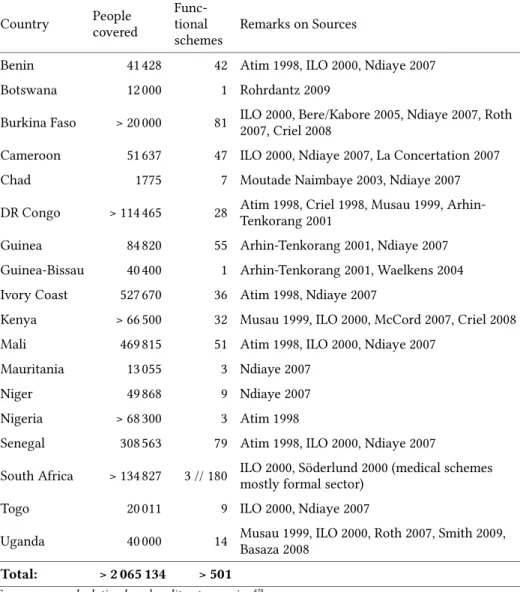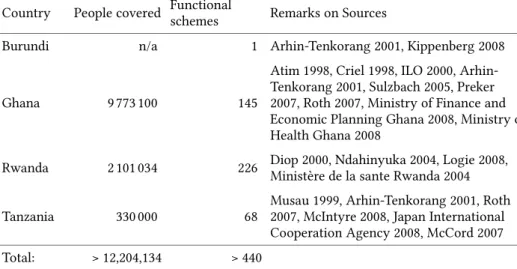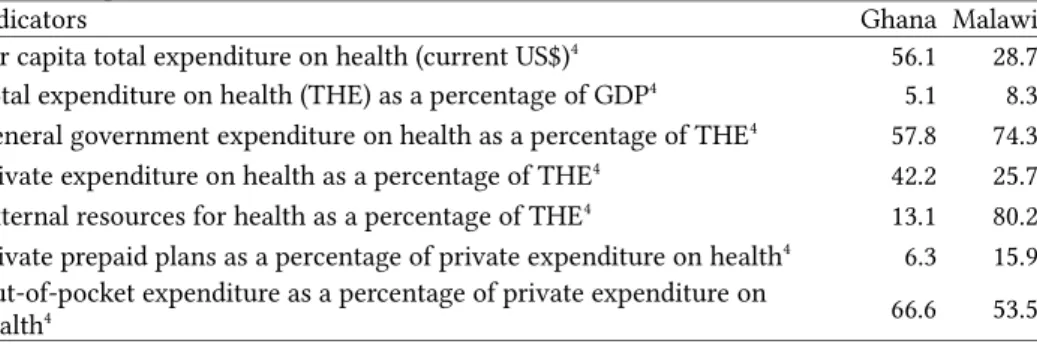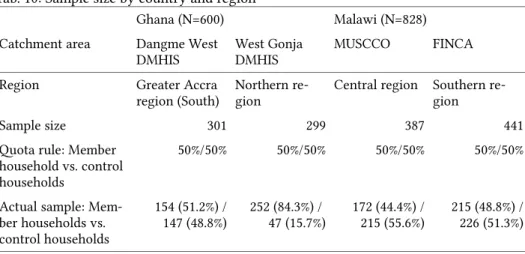Social Risk Management Strategies and Health Risk Exposure
Insights and Evidence from Ghana and Malawi
Titel der Dissertation:
Social Risk Management Strategies and Exposure to High Health Risks
in Developing Countries
Theoretical insights and empirical evidence from the Sub- Saharan countries Ghana and Malawi
Inauguraldissertation zur Erlangung des Doktorgrades
der Wirtschafts- und Sozialwissenschaftlichen Fakultät der Universität zu Köln
2015
vorgelegt von
Dipl.-Volksw. Gerald Leppert aus Erlangen
Korreferent: Prof. Dr. Martina Fuchs Tag der Promotion: 28. Januar 2015
Table of Contents
1. Introduction... 1
1.1. Context & relevance... 1
1.2. Research questions... 7
1.3. Methods... 8
1.4. Structure of the study...9
2. Risk and risk structure...11
2.1. Risk characteristics and vulnerability to risks...12
2.2. Sources of risk... 19
2.3. Health risks and exposure to health risks...21
2.3.1. The nature of health risks...21
2.3.2. High-risk cases... 23
2.4. The dual economic burden of health risks...27
2.4.1. Health care costs and catastrophic health care spending...28
2.4.2. High-cost cases...29
3. Social risk management...32
3.1. The social risk management framework...32
3.2. Criticism and recent developments of the SRM framework...37
3.3. Adaptation of the social risk management framework...42
3.4. Social risk management strategies in the adaptation of the SRM framework....48
4. Risks and social risk management in Sub-Saharan Africa...62
4.1. Introduction to country focus on Ghana and Malawi...62
4.2. Risks, risk exposure and vulnerability in Sub-Saharan Africa...65
4.2.1. General risk exposure and vulnerability in Sub-Saharan Africa...65
4.2.2. Health risks and burden of disease in Sub-Saharan Africa with particular focus on Ghana and Malawi...68
4.3. Social risk management in Sub-Saharan Africa...72
4.3.1. Social risk management on individual and household level in Sub-Saharan Africa... 75
4.3.2. Social risk management on community-level and market-based SRM strategies in Sub-Saharan Africa...78
4.3.3. Social health risk management strategies and the sequence of their application in Sub-Saharan Africa...85
4.3.4. History and trends in health care financing systems in Sub-Saharan Africa. 91 4.3.5. Micro health insurance in Sub-Saharan Africa...95
4.3.5.1. Outreach and roles of micro health insurance in Sub-Saharan Africa...97
4.3.5.2. Challenges of micro health insurance in Sub-Saharan Africa...105
Saharan Africa... 108
4.3.6. Health care financing systems in Ghana and Malawi...109
4.3.6.1. System of health care financing in Ghana...109
4.3.6.2. System of health care financing in Malawi...114
4.3.6.3. Comparison of health care financing indicators in Ghana and Malawi...119
5. Methods... 123
5.1. Background of the study...123
5.2. Household survey... 124
5.2.1. Study setting and partner organizations...124
5.2.2. Scope and structure of the survey...126
5.2.3. Household sampling strategy and data collection...128
5.3. Statistical methods used in analysis...130
6. Analytical framework and hypotheses...134
6.1. Analytical framework and structure of analysis...134
6.2. Hypotheses... 137
6.3. Operationalization of variables...140
7. Analysis... 150
7.1. Descriptive analysis...150
7.2. Household exposure to general risks...155
7.3. Exposure of individuals and households to high health risks and high health care costs... 168
7.3.1. Exposure to health risks...168
7.3.2. Individual and household exposure to high health care costs...185
7.4. Application of social (health) risk management strategies...194
7.4.1. Main country-specific differences in the application of SRM strategies...203
7.4.2. Household characteristics and application of SRM strategies...208
7.4.3. High risk exposure and household's SRM strategies...215
7.4.4. Exposure to high health care costs and household's SRM strategies...222
7.4.5. Relationship of high-risk and high-cost households with SRM strategies...228
7.4.6. Multivariate analysis on complexity of SRM strategies...234
7.5. Health insurance as SRM strategy and demand for health insurance...240
7.5.1. Willingness to pay for health insurance...240
7.5.2. Health insurance as SRM strategy in relation to risk exposure and other SRM strategies... 250
8. Conclusion... 252 9. Appendices... I 10. Bibliography...XXXVII
List of Figures
Fig. 1: Typology of social risk management strategies...45
Fig. 2: Sources of health care financing...90
Fig. 3: Micro health insurance in Sub-Saharan Africa...99
Fig. 4: Conceptual framework...135
Fig. 5: Distribution of high-risk and high-cost households in overall sample...143
Fig. 6: Household exposure to general risks with negative economic impact, by country ... 156
Fig. 7: Expected relationship between age, other risk factors and high health care costs ... 168
Fig. 8: Total individual illness costs in Euro (illness episodes, 3 months) by gender....170
Fig. 9: Total individual illness costs in Euro (episodes, 3 months) by country...171
Fig. 10: Percentage of individuals with chronic conditions by age group...172
Fig. 11: Percentage of individuals reporting hospitalization (> 3 days) by age group. .179 Fig. 12: Concentration curve of total individual treatment costs (Malawi)...186
Fig. 13: Concentration curve of total individual treatment costs (Ghana)...187
Fig. 14: Core-density estimation of health care costs in Ghana...188
Fig. 15: Number of applied SRM strategies as percentage of households...197
Fig. 16: Social risk management strategies as used by households (in percent)...198
Fig. 17: Most frequently applied sets of SRM strategies of all households (over 50% of households)... 202
Fig. 18: Most frequently applied sets of SRM strategies in Ghana (over 50% of households)... 204
Fig. 19: Most frequently applied sets of SRM strategies in Malawi (over 50% of households)... 205
Fig. 20: Most frequently applied sets of SRM strategies of member households in the local partner organizations in Malawi (over 50% of households)...206
Fig. 21: Most frequently applied sets of SRM strategies of non-member households of the local partner organizations in Malawi (over 50% of households)...207
Fig. 22: Relation of age of head of household and household size to complexity of SRM strategies... 209
Fig. 23: Number of SRM strategies by exposure of households to severe general risks, without health risks (4 classes)...216
Fig. 24: Most frequently applied sets of SRM strategies of high-risk households (over 50% of households)...219
Fig. 25: Most frequently applied sets of SRM strategies of low-risk households (over 50% of households)...219
Fig. 26: Most frequently applied sets of SRM strategies of high-risk households in Ghana (over 50% of households)...220
Fig. 27: Most frequently applied sets of SRM strategies of high-risk households in Malawi (over 50% of households)...221
Fig. 28: Most frequently applied sets of SRM strategies of high-cost households (over 50% of households)...222
Fig. 29: Most frequently applied sets of SRM strategies of low/medium-cost households (over 50% of households)...222
Ghana (over 50% of households)...223
Fig. 31: Most frequently applied sets of SRM strategies of high-cost households in Malawi (over 50% of households)...224
Fig. 32: SRM strategies by health care costs quartiles (illness episodes)...225
Fig. 33: Details on the use of savings by health care costs quartiles (illness episodes) 226 Fig. 34: Details of borrowing by health care costs quartiles...227
Fig. 35: Distribution of original and transformed willingness to pay variable...I Fig. 36: Most frequently applied sets of SRM strategies of member households in the local partner organizations in Ghana (over 50% of households)...IV Fig. 37: Most frequently applied sets of SRM strategies of non-member households in the local partner organizations in Ghana (over 50% of households)...V List of Tables Tab. 1: Sources of risk and level of occurrence...20
Tab. 2: Social risk management strategies – matrix of response levels and strategies...60
Tab. 3: Basic general, economic and development indicators for Ghana and Malawi....63
Tab. 4: Estimated DALYs per 1000000 population by cause: Ghana, Malawi (2004)...70
Tab. 5: Micro health insurance units in Sub-Saharan Africa, 2009 (independent entities) ... 102
Tab. 6: National health care financing based on micro health insurance schemes (2009) ... 104
Tab. 7: Sources of funding of Ghana NHIS (2009)...112
Tab. 8: Intervention areas and included services of the Essential Health Package...115
Tab. 9: Selected indicators on health care financing, health care provision and health system outputs, Ghana and Malawi...121
Tab. 10: Sample size by country and region...130
Tab. 11: Structure and steps in analysis...137
Tab. 12: Main (dependent) variables...140
Tab. 13: List of independent variables and their measurements...144
Tab. 14: General sample description...151
Tab. 15: Basic household characteristics...152
Tab. 16: Economic characteristics of household...153
Tab. 17: Monthly total household income (quintiles)...154
Tab. 18: Household exposure to general risks (all and severe risks)...155
Tab. 19: Household exposure to general risks with negative economic impact by regions and household environment (% of households)...157
Tab. 20: Relationship of wealth quintiles and exposure to severe non-health related general risks (both countries)...159
Tab. 21: Relationship of education of head of household and exposure to severe non- health related general risks (both countries)...160
Tab. 22: Determinants of number non-health risks with negative economic impact exposed to (multivariate linear regression)...162
Tab. 23: Determinants of number non-health risks with negative economic impact exposed to: Country comparison (multivariate linear regression)...165
Tab. 24: Determinants of individual chronic diseases (multivariate logistic regression)
... 174
Tab. 25: Determinants of individual chronic diseases: Country comparison (multivariate logistic regression)...177
Tab. 26: Determinants of long hospitalization stays (multivariate logistic regression) ... 180
Tab. 27: Determinants of long hospitalization stays: Country comparison (multivariate logistic regression)... 183
Tab. 28: Determinants of high cost households (multivariate logistic regression)...190
Tab. 29: Determinants of high cost households: Country comparison (multivariate logistic regression)... 193
Tab. 30: Social risk management strategies used for the analysis...196
Tab. 31: Frequency of pairs of SRM strategies...200
Tab. 32: Application of SRM strategies by country...203
Tab. 33: SRM strategies by membership in local partner institution (Malawi)...206
Tab. 34: Application of SRM strategies by age of head of household and hh size...209
Tab. 35: SRM strategies by sex of head of household...210
Tab. 36: SRM strategies by child/adult ratio (dichotomous: <1; >=1)...211
Tab. 37: SRM strategies by educational level of head of household...212
Tab. 38: SRM strategies by predominant household religion...212
Tab. 39: Application of SRM strategies by wealth quintiles...213
Tab. 40: SRM strategies by household exposure to general risks, without health risks ... 217
Tab. 41: SRM strategies by health risk classification of household...218
Tab. 42: Relationship of high-risk and high-cost with complexity of SRM strategies..229
Tab. 43: Use of SRM strategies in relationship to high-risk and high-costs...230
Tab. 44: High-risk / high-cost hh and complexity of SRM strategies by country...231
Tab. 45: Use of SRM strategies in relationship to high-risk and high-costs in Ghana..232
Tab. 46: Use of SRM strategies in relationship to high-risk and high-costs in Malawi 232 Tab. 47: Determinants of SRM set complexity (multivariate linear regression)...236
Tab. 48: Determinants of SRM set complexity: country comparison (multivariate linear regression)... 238
Tab. 49: Determinants of Willingness to Pay (multivariate linear regression)...242
Tab. 50: Determinants of Willingness to Pay: Country comparison (multivariate linear regression)... 246
Tab. 51: Health insurance membership in relation to SRM sets and risk exposure (multivariate logistic regression)...251 Tab. 52: Pairwise correlation matrix of SRM strategies...I
Appendices
Appendix 1: Distribution and outliers' detection of willingness to pay...I Appendix 2: Association table of SRM strategies...I Appendix 3: Complete table of sets of SRM strategies...II Appendix 4: Sets of SRM strategies split by membership in local partner organization
in Ghana... IV Appendix 5: Pro MHI Africa - Household Survey Questionnaire...VI
2a to the Questionnaire)...XXXII Appendix 7: Codes for Symptoms/Illnesses (Annex 2b to the Questionnaire)...XXXIII Appendix 8: Payment Card: Ghana (Annex 3 to the Questionnaire)...XXXV Appendix 9: Cards with Health Insurance Services (Annex 5 to the Questionnaire)
... XXXVI
Abbreviations and Acronyms ADL Activities of Daily Living ART Anti-Retroviral Therapy
ASCA Accumulating Savings and Credit Association CAM Carte d'Assurance Maladie
CCT Conditional Cash Transfers
CHAM Christian Health Association Malawi DALY Disability-Adjusted Life Year
DCG/HCC Diagnostic Cost Groups and Hierarchical Condition Categories DMHIS District Mutual Health Insurance Schemes (Ghana)
EHP Essential Health Package
FINCA Foundation for International Community Assistance GDP Gross Domestic Product
GHS / Gc New Ghana Cedis (currency) GNI Gross National Income HDI Human Development Index
HH Household
ILO International Labour Organization IMF International Monetary Fund
LR Likelihood Ratio
MASM Medical Aid Society Malawi MCA Multiple Correspondence Analysis MFI Microfinance Institution
MHI Micro Health Insurance MK / MWK Malawi Kwacha (currency) MoH Ministry of Health
MUSCCO Malawi Union of Savings and Credit Cooperatives (C)NCDs (Chronic) Non-communicable Diseases
NGO Non-Governmental Organization
NHIA National Health Insurance Authority (Ghana) NHIF National Hospital Insurance Fund (Kenya, Ghana) NHIS National Health Insurance Scheme (Ghana)
OECD Organisation for Economic Co-operation and Development
OLS Ordinary-least-square (estimation) OOPS Out-of-Pocket Spending
PCA Principal component analysis PPP Purchasing Power Parity
RoSCA Rotating Savings and Credit Association SACCO Savings and Credit Cooperative
SD Standard Deviation
SES Socio-Economic Status
SHG Self-Help Group
SHI Social Health Insurance
SLA Service Level Agreement (Malawi) SRM Social Risk Management
SSA Sub-Saharan Africa
SSNIT Social Security and National Insurance Trust (Ghana) STD Sexually transmitted diseases
SWAp Sector-Wide Approach
THE Total Health Expenditure / Total expenditure on health TIOLI Take-it-or-leave-it
UMEOA West African Economic and Monetary Union UNDP United Nations Development Programme UNICEF United Nations Children's Fund
USD United States Dollar
VAT Value Added Tax
VCT Voluntary Counseling and Testing VIFs Variance Inflation Factors
WHO World Health Organization WTP Willingness to Pay
1. Introduction
1. Introduction
1.1. Context & relevance
Risk exposure is a main cause of poverty, deprivation and persistent vulnerability of individuals and households worldwide. A decline of well-being as a result of risk oc- currence is a common and unifying experience for every human-being. Risks such as illness, injury or problems related to old age, unemployment or price fluctuations, har- vest failure and weather shocks or natural disasters, crime or domestic violence can have devastating effects on the individual and household's well-being, threatening its level of subsistence.1 Therefore, as a result of risks, individuals and households devote a considerable amount of physical and cognitive energy, as well as social engagement, responding to shocks and averting transitory or permanent damage.
However, risk exposure is not evenly distributed. The level of exposure to risks sig- nificantly varies between countries and between individuals and households. Individu- als and households in low-income countries may experience a considerably higher risk exposure, as they often live in an environment with economic, social and political in- stabilities, and experience environmental or natural disasters. Poorer households tend to be more exposed to risks than wealthier households, mostly due to their more dan- gerous and less protected living circumstances. Also, illness is not evenly distributed.
Some individuals and households are extraordinarily exposed to health risks and high health care costs. Empirically, a relatively small percentage of households face health care costs that far exceed average health care costs. Generally, health risks, and the re - sulting health care costs, occur randomly. However, some individuals and households systematically show a higher likelihood of experiencing high health care costs. A vari- ety of risk factors exist that can explain future above average health care costs, with chronic diseases being only the most prominent example. Health risks cause a double negative impact on individuals and households, firstly due to the loss of health itself and secondly due to illness-related costs. These include the actual direct treatment costs and indirect costs, such as lost income of the ill, disabled or injured person and, potentially, other household members caring for him/her.
Even more than the variation of pure risk exposure, the mechanisms put in place in order to eliminate or reduce the probability of risks and reduce the burden of the re-
1 cp. The World Bank (2001): Attacking Poverty. World Development Report 2000-2001. Oxford Univ Press. Washington, D.C., p. 137f.
sulting shock also vary. Individuals and households use a wide array of risk manage- ment strategies in order to respond to risks and to protect themselves from shocks. Risk management strategies are not limited to the household level. They stretch from the in- dividual to the global level; from small cash savings at home, earmarked for emergency cases, to community-built dams for flood prevention, insurance schemes against a vari- ety of risks and vaccination programs to prevent communicable diseases, and to global institutions for economic stability or the global initiative to fight HIV/AIDS. All these strategies aim to reduce insecurity, uncertainty and vulnerability to shocks.
Poor households not only face higher risk exposure to a wider array of risks than wealthier households, but the capacity to cope with risks and the availability of risk management strategies is much lower.2 Among poor or near-poor households, risks have a higher impact, because they can lead to (reinforcing) poverty and a dramati- cally reduced standard of living. These dynamics are frequently described by the terms vicious cycle of poverty or deprivation trap explaining the mutually reinforcing inter- play between poverty, vulnerability, physical weakness, powerlessness and isolation.3 Insufficient response to risks is moving households into or deeper into poverty, thus keeping the household in the deprivation trap. Making risk management capacities a central consideration is essential for escaping the trap.
Health risks are more likely to cause a deprivation trap than other types of risks.
First, unlike many other risks which may affect only a certain, often clearly defined, sub-group, health risks have the potential to affect every individual. The aforemen- tioned double-burden of health risks explains why health risks are a main cause for falling into the deprivation trap. Poverty causes a poor health status, which increases health care needs and treatment costs that may lead to further impoverishment or may drop the household below the poverty line.4 If the household decides to forgo treat- ment due to unaffordability or inaccessibility of health care services, the health status is likely to worsen. Thus, foregone treatment or the unavailability of acceptable quality health care intensifies households' ill health and often results in long-term or a perma- nently reduced income-earning capacity.5
2 Ibid., p. 135.
3 Swanepoel, Hennie; Beer, Frik De (2006): Community Development: Breaking the Cycle of Poverty, 4 edition. Juta and Company Ltd. Lansdowne, South Africa, p. 4f.
4 Leive, Adam; Xu, Ke (2008): Coping with Out-of-Pocket Health Payments. Empirical Evidence from 15 African Countries. In: Bulletin of the World Health Organization, vol. 86, nr. 11, pp. 849–
5 856.Dodd, Rebecca; Munck, Lise (2002): Dying for Change. Poor People’s Experience of Health and Ill- Health. URL: http://www.worldbank.org/poverty/voices/reports/dying/ (accessed 2014/08/02);
Meessen, Bruno; Zhenzhong, Zhang; Van Damme, Wim; et al. (2003): Iatrogenic Poverty. In: Tropi- cal Medicine and International Health, vol. 8, nr. 7.
1.1. Context & Relevance
There is little doubt that the chronically poor are dependent on social assistance in or- der to manage (some of) their risks, as their capacity for self-help is generally low. On the other hand, the large group of transitory poor are the ones that, if hit by shocks or calamities, may drop below the official poverty line.6 The transitory poor may have productive self-help capabilities and a successful set of risk management strategies that could remove them from poverty or that could make them resilient enough not to face a severe or permanent drop due to the shock.7 Supporting the effectiveness of risk management strategies can be an effective tool to reduce the overall vulnerability of these households and is a "necessary investment for achieving sustainable and equi- table economic growth"8.9
The risk management capacities of households depend not only on their economic situation, but also depend heavily on the social, political and institutional environment at the local, regional, national and global levels. Those living in developing countries are not only exposed to more risks, but they are also more vulnerable, as they have limited access to risk management strategies on a systemic level (e.g. credit or insur- ance). Due to the unavailability or inaccessibility of certain risk management strategies for households in developing countries, protection from major risks is frequently in- sufficient and their own risk management capacities are overwhelmed, if strategies at a higher level (local, national or global) turn out to be inadequate.
The analysis of this study is based on a framework proposed by Holzmann and Jør- gensen as an approach to analyze risk management capacities of households in their social and political environment. The core of the Social Risk Management (SRM) frame- work is a classification of all kinds of strategies that enable households to manage their income risks and that distinguishes between risk reduction, risk mitigation (proactive) and risk-coping (reactive) strategies.10 For the purpose of this study, the framework was extended in several ways, incorporating later developments and criticisms of the
6 cp. Waelkens, Maria-Pia; Criel, Bart; Soors, Werner (2005): The Role of Social Health Protection in Reducing Poverty. The Case of Africa. International Labour Organization. Geneva, p. 15. URL:
http://papers.ssrn.com/sol3/papers.cfm?abstract_id=7030561 (accessed 2009/08/31).
7 cp. Baulch, Bob; Hoddinott, John (2000): Economic Mobility and Poverty Dynamics in Developing Countries. In: Journal of Development Studies, vol. 36, nr. 6, p. 18.
8 Holzmann, Robert; Kozel, Valerie (2007): The Role of Social Risk Management in Development. A World Bank View. In: IDS Bulletin, vol. 38, nr. 3, p. 8.
9 Rösner, Hans Jürgen (2013): Mikrofinanzsystementwicklung und produktive Selbsthilfe. In: Ihne, Hartmut (ed.): Einführung in die Entwicklungspolitik. Münster, p. 309; Holzmann et al. (2007): The Role of Social Risk Management in Development, p. 8.
10 The SRM framework was developed with the aim to rethink the Social Protection Sector Strategy of the World Bank, see Holzmann, Robert; Jørgensen, Steen L. (1999): Social Protection as Social Risk Management. Conceptual Underpinnings for the Social Protection Sector Strategy Paper. In:
Social Protection Discussion Paper Series, vol. 9904.
original concept. The extended framework helps to systematically analyze SRM strate- gies that are applied by households and are accessible to them.
The management of health risks requires SRM strategies on multiple levels from the individual to the global level. Proper management of health risks requires a function- ing health care system on all levels, which guarantees the provision of a financially and geographically accessible medical infrastructure for all households, with preven- tion policies and structures to respond to unforeseen changes in epidemiological pat- terns.11 In developing countries, health care (financing) systems often function poorly and favor formal sector employees. Often, poor households, and those working in the informal sector, have only restricted access to proper health care. Similarly, health care financing systems are weak, so that individuals and households are not sufficiently protected from catastrophic health care costs. If access to health care is not provided for free, health insurance plays a pivotal role in successfully protecting households from high health care costs. Health care costs show severe fluctuations that may ex- ceed individuals' or households' risk management capacities. Pooling health risks over a large number of people, which is the basic principle behind health insurance, is seen as an effective and recommended risk management strategy for health risks.12
Although the role of social risk management in social protection is widely accepted, exposure to risks, the actual use of social risk management strategies, the sequence of their application, the dependency of social risk management on the institutional set- ting, and limitations on access to social risk management strategies in developing countries have been empirically tested an astonishingly small number of times. A wide range of literature exists on the topic, but most studies on social risk management strategies have several limitations: The main body of publications was produced in the form of assessments, studies or reports closely linked to project implementation or linked to development agencies.13 Sometimes these studies do not entirely follow aca-
11 cp. WHO (2000): World Health Report 2000. Health Systems. Improving Performance. World Health Organisation. Geneva, p. 25.
12 Meessen et al. (2003): Iatrogenic Poverty, p. 582; Kawabata, Kei; Xu, Ke; Carrin, Guy (2002): Pre- venting Impoverishment through Protection against Catastrophic Health Expenditure. In: Bulletin of the World Health Organization, vol. 80, nr. 8, p. 612.
13 See for example: Flory, Jeffrey; Nagarajan, Geetha (2009): The Poor and Their Management of Shocks. Financial Services Assessment Project. IRIS Center. College Park, MD; The World Bank (2007): Malawi Poverty and Vulnerability Assessment. Full Report. World Bank. Washington, D. C.
URL: http://documents.worldbank.org/curated/en/2007/12/909050930/malawi-poverty-vulnerability- assessment-investing-future-vol-2-3-full-report (accessed 2014/08/13); Example for purposive sam- pling of clusters: Devereux, Stephen (1999): ‘Making Less Last Longer’. Informal Safety Nets in Malawi. IDS Discussion Paper. Institute of Development Studies. no place. URL: http://www.eldis- .org/vfile/upload/1/document/0708/DOC7793.pdf (accessed 2014/04/06); Waelkens et al. (2005):
The Role of Social Health Protection in Reducing Poverty.
1.1. Context & Relevance
demic standards and the application of rigorous research methods. Other studies nar- row their perspective to one kind of risk, such as health, drought or natural disaster risks.14 Some older studies on risk coping do not incorporate the SRM framework, but use earlier typologies or classifications; this is sometimes problematic when these stud- ies also have a narrower scope than the SRM framework, e.g. focusing on reactive cop- ing strategies and neglecting proactive strategies.15 Almost all studies focus on only one country, which does not give a holistic and in-depth picture of social risk manage- ment as different study designs make meaningful country comparisons impossible.
This study is based on the data from an international household survey, allowing for a comprehensive analysis of social risk management strategies by households and indi- viduals between Ghana and Malawi, as the same research instruments were used in both countries. The comparison follows the logic of the 'most similar case design,' which seeks cases that are similar in a variety of aspects, but have significant differ- ences in variables of interest that shape patterns of behavior.16 Ghana and Malawi were selected for the comparison of individual and household risk exposure to general risks and health risks, as well as related social risk management strategies. These two coun- tries are suitable for the comparison of social risk management strategies as they share a variety of factors and differ in certain factors of interest. Both countries are located in the Sub-Saharan African region, have a history of British colonialism, are predomi- nantly rural and rely on agricultural production. They have functioning democracies with the experience of a peaceful change of government. Both countries are not ex- posed to violent conflicts and riots, wars or large natural/environmental disasters, be- sides seasonal disasters such as drought, floods and fire. Ghana and Malawi are quite stable in terms of their ethnic composition and without major ethnic conflicts.
However, both countries differ in some important aspects relevant for the compari- son of social risk management strategies. There are significant differences in terms of history and the institutional arrangement of the health care financing systems. While
14 See for example: Sauerborn, R.; Adams, A.; Hien, M. (1996): Household Strategies to Cope with the Economic Costs of Illness. In: Social Science & Medicine, vol. 43, nr. 3, p. 293ff.; Keil, Alwin; Zeller, Manfred; Wida, Anastasia; et al. (2008): What Determines Farmers’ Resilience towards ENSO-Re- lated Drought? An Empirical Assessment in Central Sulawesi, Indonesia. In: Climatic Change, vol.
86, nr. 3-4.
15 See for example: Montgomery, Richard (1996): Disciplining or Protecting the Poor? Avoiding the Social Costs of Peer Pressure in Micro-Credit Schemes. In: Journal of International Development, vol. 8, nr. 2, p. 292f.; Sommerfeld, Johannes; Sanon, Mamadou; Kouyate, Bocar A.; et al. (2002): In - formal Risk-Sharing Arrangements (IRSAs) in Rural Burkina Faso. Lessons for the Development of Community-Based Insurance (CBI). In: International Journal of Health Planning and Management, vol. 17, nr. 2, p. 153ff.
16 Meckstroth, Theodore W. (1975): I. ‘Most Different Systems’ and ‘Most Similar Systems’ A Study in the Logic of Comparative Inquiry. In: Comparative Political Studies, vol. 8, nr. 2, p. 133.
Ghana has implemented a National Health Insurance Scheme (NHIS) in 2003 that aims to include people working in the informal economy and aims to cover a wide variety of services, Malawi continues to rely on a tax- and donor-financed health care system which aims to provide basic services for free, in the so-called Essential Health Package (EHP). It is expected that SRM strategies of individuals and households are heavily in- fluenced by the institutional environment. Notwithstanding the suitability of Ghana and Malawi for the comparison of SRM strategies, it needs to be noted that there are other differences between the countries that might influence SRM behavior, and there- fore need to be considered in the analysis. For example, Ghana has a significantly higher economic production, ranks somewhat higher in the Human Development In- dex (HDI) and suffers much less from the HIV/AIDS pandemic than Malawi. Also, the culture and cultural heritages show differences likely to influence SRM-related behav- ior.
This study compares exposure to a variety of risks, with an explicit focus on health risks, and the related risk management strategies of individuals and households in Ghana and Malawi. The analysis allows for insights into the relationship of SRM strategies with a variety of external and household-internal factors. It enables us to un- derstand the application of SRM strategies dependent on the level of risk exposure and to observe the sequence of the application of SRM strategies in relationship to increas- ing severity of a shock. The comparison between Ghana and Malawi allows for more generalized conclusions, as systemic differences in SRM become clearer, similarities of risk behavior of low-income households can be extracted and effects of institutional differences can be identified. The comparative method allows explaining and interpret- ing the differences in proactive and reactive social risk management behavior, not only between different groups and dependent on different determinants within a country, but also understanding what SRM behavior is triggered by systemic differences be- tween the countries.17
In this study, health insurance is acknowledged as a significant SRM strategy to mit- igate health shocks; health insurance is recommended by many researchers as its risk pooling mechanism has certain strengths that most other SRM strategies lack.18 For this reason, a considerable part of the analysis is devoted to analyzing the relevance of
17 For the rationale of country comparisons, see: Sartori, Giovanni (1991): Comparing and Miscom- paring. In: Journal of Theoretical Politics, vol. 3, nr. 3, p. 244ff.
18 Hsiao, William; Shaw, Paul (eds.) (2007): Social Health Insurance for Developing Nations. WBI De- velopment Studies. The World Bank. Washington, D.C., p. 1. URL: http://www.hsph.harvard.edu/
phcf/publications/Hsiao.Shaw.20077.SHI.developing.countries.1.2.pdf; Meessen, Bruno; Criel, Bart;
Kegels, Guy (2002): Formal Pooling of Health Risks in Sub-Saharan Africa. Reflections on the Ob- stacles Encountered. In: International Social Security Review, vol. 55, nr. 2, p. 582f.
1.1. Context & Relevance
health insurance as an SRM strategy. However, conceptually, health insurance will be treated as just one of many SRM strategies for health risks. Applying such a holistic perspective on social health risk management strategies allows for better understand- ing of positioning the strategy health insurance in their use by individuals and house- holds, in relationship to other SRM strategies (such as savings, credit, social capital, etc.), as well as public health care provision.
1.2. Research questions
The main interest of this study is to empirically evaluate the use and application of strategies, by individuals and households, to manage risks and cope with shocks. A particular emphasis is placed on health risks. The comparison of Ghana and Malawi al- lows for the evaluation of the relevance of health insurance, commonly seen as the main tool to cope with health care costs, as a social risk management strategy. Gener- ally, there has been little research done concerning the way individuals and households use their wide array of SRM strategies and how these households build up their sets of SRM strategies depending on a variety of factors. This study aims to fill this knowledge gap with an empirical evaluation based on household survey data.
Other studies indicate that SRM strategies depend on a variety of socio-economic and geographic factors, as well as system configurations from a micro to a global level.
The applied social risk management strategies and the complexity of the sets of SRM strategies were analyzed. The sequence of the application of proactive and reactive strategies by households in relationship to the severity of the shock(s) deserves a par- ticular focus. The main research interest of this study centers on individuals and households that have a high exposure to general risks and/or health risks. Due to the higher risk exposure, these households are more vulnerable than others and need to rely on effective social risk management strategies. Therefore, these households are as- sumed to behave differently from other households with regard to social risk manage- ment. The main research question addresses this complex relationship:
In what ways is high risk exposure related to the application of social risk management strategies by households and individuals in developing countries?
Fully addressing this main research question leads to five sub-questions that are being subsequently addressed in the main analysis and discussion of the study:
1. What social (health) risk management strategies are applied by households and in what sequence and complexity are they applied?
2. In what ways are exposure to high general and high health risks associated with the application of particular sets of social risk management strategies by house- holds?
3. What is the level of exposure of individuals and households to high general risks and high health risks?
The fourth and fifth research sub-questions focus explicitly on health insurance as an SRM strategy. The fourth question elaborates on the significant differences in health risk management between households who have health insurance coverage and those who do not. This difference is triangulated using the country comparison of Ghana and Malawi, as Ghana already offers a national health insurance scheme, called NHIS. The fifth question differs from the previous ones as it introduces a forward looking aspect, by analyzing a hypothetical health insurance product and its relation to households' risk exposure and the application of other SRM strategies. The fifth sub-question there- fore concludes the analysis:
4. In what ways does health insurance coverage relate to households' application of other SRM strategies?
5. What does high risk exposure, in combination with existing SRM strategies of households, imply for the demand for health insurance as an SRM strategy, by as- sessing households' willingness to pay for a hypothetical health insurance product?
In the empirical sections of this study, the research sub-questions will be addressed one after another in order to be able to subsequently and thoroughly answer the main re- search question.
1.3. Methods
The study combines a literature review on several key concepts and their adaptation to the study, with a quantitative analysis of household survey data. The review of litera- ture focuses on the concepts of risks and health risks, including a discussion of high direct and indirect health care costs, the social risk management framework, key as- pects of health care financing in low- and middle income countries, micro health in- surance as a social risk management strategy and measuring demand for health insur- ance via a willingness to pay analysis.
The literature review centers on the framework of social risk management and its further development, as well as its criticism. The framework has been substantially ex- tended and adapted to health risks, as well as the context of Sub-Saharan Africa.
1.3. Methods
Households exposed to high risks or high costs are expected to behave differently from other households. Hence, mechanisms have been developed to identify high-cost and particularly high-risk households, evaluating a variety of sources including literature on risk adjustment mechanisms of health insurance schemes in competitive health in- surance markets. A second step focuses on the empirical evidence of these concepts in Ghana and Malawi and the operationalization of the concepts for data analysis.
Data from an international comparative household survey conducted in Ghana and Malawi is the basis of the multi-faceted comprehensive quantitative analysis. The household survey was designed and conducted by the author, who worked on all as- pects of the study as project coordinator for the project Pro-MHI-Africa, together with colleagues from the University of Cologne and project partners from the University of Ghana, University of Malawi and University of Botswana. The cross-sectional house- hold survey was conducted in Ghana, Malawi and Botswana from the 8th of March un- til the 5th of May 2009. This study uses the data from Ghana and Malawi in order to al- low for a two-country comparison based on a most similar case design.19 Both coun- tries show larger inter-regional differences than international differences on many as- pects and variables. In terms of health risk management, the countries substantially differ, particularly since Ghana introduced the National Health Insurance Scheme (NHIS) aimed to be the main social risk management strategy to avoid high health care costs and improve access to health care.
A total of 1428 households were interviewed in these two countries, 600 in Ghana and 828 in Malawi. Information on 7088 individuals was recorded from these house- holds, 3088 in Ghana and 4000 in Malawi. The data are two-level data with information at the household level and core sections on health care utilization at the individual level. Analysis is conducted with the statistical software Stata 13.120 applying a variety of univariate, bivariate and multivariate statistical techniques on individual and house- hold levels.
1.4. Structure of the study
The first part of the study (sections 2 and 3) elaborates on the theoretical background for further analysis, based on a thorough literature review. In these sections, the main
19 The data of the sub-survey in Botswana were not included in this study for several reasons, partic- ularly due to the status of Botswana as a middle income country in contrast to Ghana and Malawi as low-income countries, differences in the sample design and a much smaller overall sample that did not allow for meaningful statistical analyses on subgroups with a small frequency like people with chronic conditions and high-risk households.
20 StataCorp (2013): Stata Statistical Software. StataCorp LP. College Station, TX.
concepts of the study are further established, refined and adapted for the country set- ting and analysis. The constructs of risk and health risks are fundamentally important for the analysis and are discussed in detail in section 2, including an elaboration of high-risk cases and the economic burden of health risks.
The main analysis is based on the concept of social risk management (SRM) which is presented and adapted using a variety of improvements in section 3. First, the origi- nal classification of SRM strategies developed by Holzmann and Jørgensen21 in 1999 is introduced and more recent developments of the SRM concept are outlined and criti- cally appraised. The adaptation of the SRM framework is presented in section 3.3 and the wide variety of SRM strategies (those relevant for health risks) are elaborated in section 3.4. Section 4 focuses on risks, risk exposure and social risk management in Sub-Saharan Africa, starting with an introduction to the situation in Ghana and Malawi and discussing empirical evidence of social risk management strategies in Sub- Saharan Africa.
Sections 5-7 comprise the empirical part of the study. First, the methodological background of the study is laid out in section 5, starting with a description of the quantitative household survey and the household sample in Ghana and Malawi and presenting the methods used for data analysis. The analytical framework is presented in section 6, laying the foundation for all analytical steps necessary to answer the re- search questions as posed in section 1.2 and further hypothesized in section 6.2. The variables are operationalized in section 6.3.
Section 7 contains the data analysis, which follows several steps along the central theme of the research questions and hypotheses. After presenting important descrip- tive information about the households and individuals in the sample in section 7.1, the following section 7.2 provides an in-depth analysis on the exposure of households and individuals to general risks (such as social, economic, environmental and weather risks). Section 7.3 contains an analysis of the individual and household exposure to health risks and the economic burden of illness (i.e. direct and indirect health care costs), as well as their determinants. Section 7.4 is the core of the study as it provides a thorough analysis of several SRM strategies at individual, household and community levels and the complexity of the sets of SRM strategies that households use in order to respond to risks. The analysis of determinants for the SRM strategies of households are presented. After that, a thorough analysis on the relationship of high general risk ex- posure, high health risk exposure, experience with high health care costs and SRM
21 Holzmann et al. (1999): Social Protection as Social Risk Management. Conceptual Underpinnings for the Social Protection Sector Strategy Paper.
1.4. Structure of the Study
strategies is provided. Several hypotheses are tested elaborating these complex rela- tionships and how the behavior of high-risk and high-cost households differs with re- gard to their SRM strategies. In section 7.5, health insurance as an SRM strategy and the determinants of the demand for health insurance are analyzed. First, the prospec- tive view on health insurance is analyzed using households' willingness to pay (WTP) for a hypothetical health insurance product, as proxy for the demand for health insur- ance. After that, health insurance membership is analyzed in its relationship with risk exposure and the existence of other SRM strategies. Section 8 concludes the study with a summary of the results and addressing the research questions.
2. Risk and risk structure22
Like all households, low-income households are exposed to various kinds of risks, which they try to handle using complex arrays of social risk management strategies.
Particularly, low-income households in developing countries are vulnerable to risks, as even minor shocks can cause severe hardship and can put the household in destitu- tion.23 Generally, poor households have few assets to protect themselves and have less means to respond to risks. These insights put the construct risk as a central focus of poverty analysis and social protection.24
In the following, risk shall be understood as the variation of the outcomes of an un- certain future event, while probabilities, based on experience values, can be assigned to this variation and the occurrence of the event itself. As some risks contain a specula- tive chance to win or lose, a narrow definition of risk strictly refers to such future events that involve a loss, in case the event occurs.25 Throughout the study, this narrow
22 This chapter is partially based on a previously published article by the author, but contains sub - stantial changes and large parts have been rewritten: Leppert, Gerald (2012): Financing Health Care. The Role of Micro Health Insurance in Sub-Saharan Africa. In: Bloemertz, Lena; Doeven- speck, Martin; Macamo, Elisio; et al. (eds.): Risk and Africa. Multi-Disciplinary Empirical Ap- proaches. Berlin.
23 Dercon, Stefan (2007): Risk, Insurance, and Poverty: A Review. In: Dercon, Stefan (ed.): Insurance against poverty, Repr. UNU-WIDER studies in development economics. Oxford Univ. Press. Ox- ford [a.o.], p. 9 and 28.
24 cp. The World Bank (2001): Dynamic Risk Management and the Poor. Developing a Social Protec- tion Strategy for Africa I. Social Protection Strategy. World Bank. Washington, D.C., p. xi. URL:
http://documents.worldbank.org/curated/en/2001/01/100470431/dynamic-risk-management-poor- developing-social-protection-strategy-africa-vol-1-2-main-report (accessed 2014/07/21).
25 Rösner, Hans Jürgen (2008): Risikomanagementstrategien für arme ländliche Bevölkerungsgrup- pen. In: Zeitschrift für das gesamte Genossenschaftswesen, vol. Sonderheft 2008, p. 18; The World Bank (2001): Attacking Poverty. World Development Report 2000-2001, p. 139; Aven, Terje (2008):
Risk analysis. Wiley. Chichester [a.o.], p. 17.
definition of risk was used, focusing on those risks causing negative shocks. These 'negative' risks can be distinguished by risk characteristics and the source of risk. Differ- ent risk characteristics and different sources of risk require different response strate- gies or interventions.26 First, section 2.1 elaborates on risk characteristics and section 2.2 on sources of risk and at which levels these risks usually hit.
2.1. Risk characteristics and vulnerability to risks
Risk is an abstract construct and difficult to understand, particularly because all risks have a significantly random component, the causal links leading to the occurrence of risks are usually not entirely known, and shocks, which are the 'visible side' of risks, can come in very different forms. Hence, to make the concept of risk useful for social risk management analysis, it is necessary to have a closer look at the differences in risk characteristics. Four main groups of risk characteristics can be distinguished. Firstly, risks differ by stochastic criteria. Secondly, they differ by the population exposed to the risk and, hence, potentially affected. Thirdly, risks can be distinguished by the level where the shock hits. Fourthly, risks differ by the extent of the shock.27
Although all risks have a random nature, the stochastic criteria of risks significantly differ in terms of their (objective) probability and frequency,28 the uncertainty of occur- rence, and the correlation between different risks or the risk itself.
The main stochastic criterion is the probability of a risk, which refers to the likeli- hood that the risk occurs to a subject in a given time period and given background knowledge. For example, if statistics show that 5 out of 100 individuals who show cer- tain symptoms develop the illness within one year, then the probability for an individ- ual who has the symptoms to fall sick with that particular illness within a year is 5%. If more background information is known, such as an individual's weakened immune system, the probability increases accordingly.29 The frequency of a risk is closely related to the probability, but needs to be conceptually distinguished. If a risk frequently oc-
26 The World Bank (2001): Social Protection Sector Strategy. From Safety Net to Springboard. World Bank. Washington D.C., p. 12. URL: http://documents.worldbank.org/curated/en/2001/
01/8280354/social-protection-sector-strategy-safety-net-springboard (accessed 2014/07/04).
27 Other, slightly different categorizations of risk characteristics can be found in: Holzmann, Robert;
Jørgensen, Steen (2001): Social Risk Management. A New Conceptual Framework for Social Pro- tection, and Beyond. In: International Tax and Public Finance, vol. 8, nr. 4, p. 539; Rösner (2008):
Risikomanagementstrategien für arme ländliche Bevölkerungsgruppen, p. 20f.
28 Contrary to objective probabilities which are a result of a thorough risk assessment, the subjective perception of probabilities differs and leads to substantial misjudgments of risk and probabilities.
When using the term ‘probabilities’, this study refers to objective probabilities if not otherwise in- dicated. Zweifel, Peter; Eisen, Roland (2003): Versicherungsökonomie, 2 edition. Springer. Berlin [a.o.], p. 40f.
29 Aven (2008): Risk analysis, p. 167f.
2.1. Risk Characteristics And vulnerability to Risks
curs, its probability to occur at least once in a given time period is increased. Hence, there is interplay between probability and frequency of risks, depending on the time period under observation. However, not all risks can be expected to occur more than once in a lifetime, examples being an HIV infection or death. The frequency of other risks is unlikely to be higher than once in a given time period, for example risks that may only occur in a particular season of the year. Other risks can occur at a higher fre- quency in a given time period, such as contracting a cold, which may happen more of- ten in a year.
Due to incomplete information, in every risk assessment there is some level of un- certainty. Whether and when a risk occurs to a particular individual, and what the ex- tent of the shock will be, is in most cases uncertain.30 An objective risk assessment may lack important data, so that the calculated probability can only approximate the real probabilities. Some risks can be largely anticipated, as they are more predictable than others; either because their likelihood significantly increases at regular intervals, shows seasonal fluctuations, or their likelihood significantly depends on a certain and known factor, such as old age, with increased illness risks, and risk of social isolation and inability to work.31 For example, the risk of seasonal food shortages is largely pre- dictable, particularly if it follows a mediocre harvest season. For example, in Malawi, the four months prior to the maize harvest are also called "hungry season",32 a typically recurring risk with a high likelihood of occurrence. Other risks cannot be easily antici- pated, such as infections and diseases, as they are largely random.
In many cases, risks are correlated with each other, so that the probability of occur- rence is not independent. Concerning correlation, two forms need to be distinguished:
Autocorrelation, between the same risk, and correlations between different risks.
The first form is autocorrelation of a risk, which means that the risk once occurred is more likely to occur again in the future. Such autocorrelation can result in an in- crease of the probability of the risk for the same individual (e.g. in the case of certain cancers or injuries of joints) or for other individuals (e.g. in the case of contagious dis- eases).33 In the first case, when the likelihood is increased that the same risk repeats it- self for the same individual, the risk has a recurring nature. In the latter case, the oc -
30 Ibid., p. 17 and 20.
31 The World Bank (2001): Dynamic Risk Management and the Poor. Developing a Social Protection Strategy for Africa I, p. 2; The World Bank (2001): Attacking Poverty. World Development Report 2000-2001, p. 137f.
32 The World Bank (2001): Dynamic Risk Management and the Poor. Developing a Social Protection Strategy for Africa I, p. 11.
33 cp. Holzmann, Robert; Jorgensen, Steen (1999): Social Protection as Social Risk Management. Con- ceptual Underpinnings for the Social Protection Sector Strategy Paper. In: Journal of International Development, vol. 11, nr. 7, p. 1013.
currence of the risk for one individual has external effects for other individuals, as there is a correlation between affected subjects; a typical example is a local flu out- break where one ill subject increases the likelihood for others in the same community.
The direction of autocorrelation is not necessarily positive (i.e. leading to an increased future risk probability) as indicated in the two examples above, but can be also nega- tive (i.e. decreasing future risk): For example, the autocorrelation of certain diseases for the same individual is negative, as is the case for measles, which is usually not con- tracted by the same individual again. An example for a negative autocorrelation with other individuals is when a risk occurrence of one individual sensitizes the others to be more cautious, such as in the case of a car accident while drunk. It is important to note that autocorrelation needs to be conceptually separated from the frequency of a risk as discussed above; frequency of a risk includes repeated risks due to autocorrelation, but is not limited to the case of autocorrelation.
The second type of correlation, between different risks, refers to the mechanism by which a risk has a causal relationship with another risk or triggers other risks. In this regard, it is necessary to distinguish between two cases:
Case 1: Risk A → Risk B
Risk A increases the probability of risk B and there is a causal relationship.
Case 2: Risk X → Risk Y, Risk Z
Risk X increases the probability of risk Y and risk Z. There is a causal relationship be- tween risk X and Y and between X and Z. However, there is no causal relationship be- tween Y and Z.
An example of the first case is that the realized risk of illness leads to the increased probability of the risk of high health care expenditures. An uncured illness may also cause negative long-term effects such as a future reduction of work ability and, finally, a reduction in income.34
The second case refers to the situation when a certain event triggers multiple risks, which correlate, but do not have a causal relationship with each other. These are typi- cally referred to as "bunched risks". An example for bunched risks is a weather-related shock such as drought, which increases the probability of several risks, such as harvest failures, livestock loss and malnutrition.35 Another example is the risk of a tsunami, in which an earthquake may cause direct damages to houses and also triggers a seismic
34 cp. The World Bank (2001): Attacking Poverty. World Development Report 2000-2001, p. 138.
35 see with regard to the risk situation of rural population: Rösner (2008): Risikomanagementstrate- gien für arme ländliche Bevölkerungsgruppen, p. 27.
